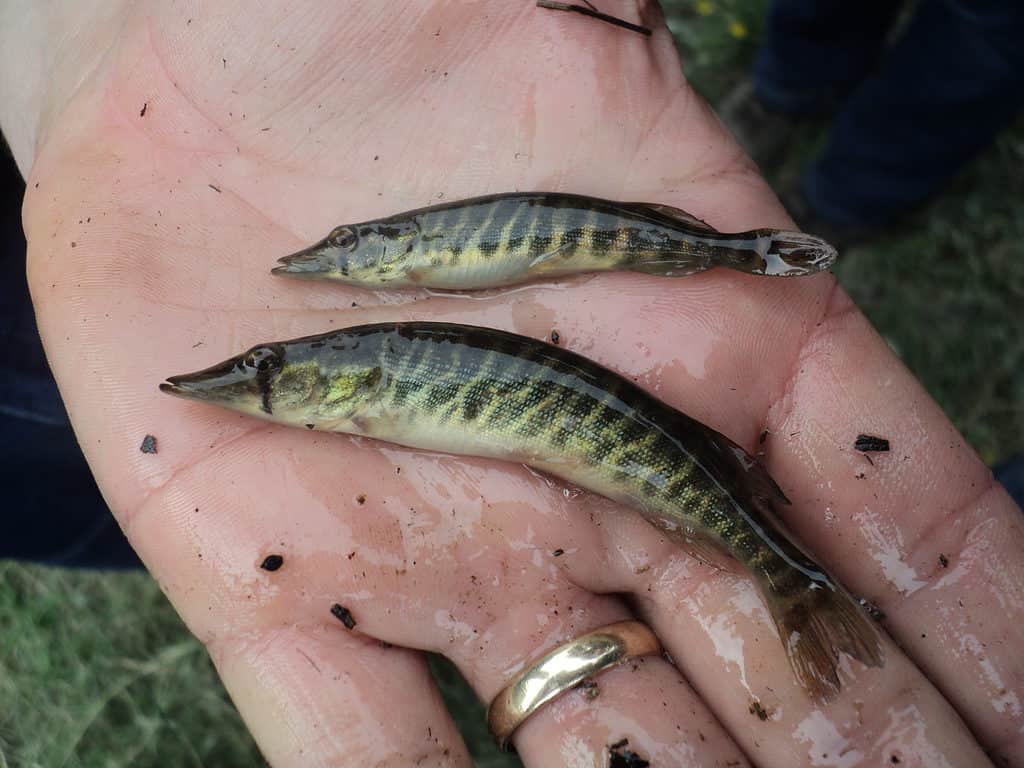Chain Pickerel
Advertisement
Chain Pickerel Scientific Classification
- Kingdom
- Animalia
Chain Pickerel Facts
Chain Pickerel Physical Characteristics
- Color
- Yellow
- Green
- Skin Type
- Scales
- Weight
- 4-7 pounds
- Length
- 2-3 feet
- Age of Sexual Maturity
- 4 years
- Venomous
- No
- Aggression
- High
View all of the Chain Pickerel images!
Fishermen on the east coast and certain parts of the Midwest and South likely know chain pickerel as a fun, feisty fish that makes an exciting catch. These predatory fish put up a fight when caught. The chain-like markings characterize them on their backs and their yellowish-green color. They also have scales that cover their cheeks, an unusual feature for a fish.
5 Chain Pickerel Facts
- These fish put up a fight when caught.
- They are a popular sport fish but are not as common to eat.
- Mother chain pickerel do not stay around to monitor or protect their eggs.
- They live from the north of Maine and Canada to the southern parts of Florida.
- Adults wait in underwater vegetation to ambush their prey.
Classification and Scientific Name
The chain pickerel is known by its scientific name Esox niger. It belongs to the Esox genus, including other types of pickerel or pikes. These fish are also called southern pike, eastern pickerel, or gunny. It is closely related to the American pickerel, another member of the Esox genus. There are seven species within the genus, and they all look and behave similarly.
They are part of the Esocidae family of fish. Some specimens of fish in this family date back as far as the Mesozoic era, between 66-252 million years ago. This means their relatives were around when dinosaurs roamed the Earth! All the fish in this family are predators, including the chain pickerel. It is one of their most recognizable behaviors.
The Esocidae belong to the Esociformes order and Actinopterygii class. This means they are ray-finned fish. Their fins are supported by bones that look like rays rather than cartilage. There are numerous families, genera, and species within this class. Over 50% of vertebrates (not just fish) are members of the Actinopterygii class. They are also part of the Chordata phylum and Animalia kingdom.
Appearance

Another distinguishing feature of chain pickerel is their scales.
©Michael Sundberg/Shutterstock.com
These fish have markings that look like chains on their bodies, giving them their name. It is one of the ways to distinguish them from other species in their genus. These markings are a bit lighter than the rest of their body, which is a yellowish-green. They have thin bodies and long snouts. This is similar to other types of pickerel and pike.
They don’t get huge, usually topping around three feet at their largest. They can get up to seven pounds. Most caught by fishermen are smaller than this, often around two feet long and 3-4 pounds. There are size limitations to what you can keep when you catch them, which vary based on the year and location. They have an extensive range, so you should always check the local regulations where you are fishing.
Another distinguishing feature of chain pickerel is their scales. Many fish only have scales on their bodies, but these fish have scales covering their cheeks and gills. They also have a dark vertical marking on their cheek, just under their eye. Because these fish are predators, they use multiple rows of sharp teeth to eat prey. Their teeth are angled inside their mouths.
Distribution, Population, and Habitat
These fish live in various climates, from the frigid waters of Canada to the much warmer climate in Florida and across Texas. It is even found in the Great Lakes. They can live in brackish water, where fresh and saltwater combine. They are also common in freshwater environments, including upstream rivers and streams.
They are native to parts of the northeast, Southern Florida, and smaller pockets in between. They have spread to nearby states and are relatively common from Maine to Florida. In Maryland, where they are a common fish for game fishermen, they live in the large Chesapeake Bay tributaries.
Chain Pickerel Predators and Prey
As their sharp teeth suggest, the chain pickerel are carnivores and eat other fish. When they are young, they stick to fish that they can overpower. As they grow, they learn to ambush even colossal fish. They grab these fish with their sharp teeth and don’t let go.
They also eat other organisms they can find in their environment or nearby. These include frogs and snakes, worms, insects, and crayfish. They can even leap out of the water to go after flying insects close to their surface. They can mistake dangling fishing lures for prey, making them an excellent catch for fishermen.
Reproduction and Lifespan
Spawning season is based on water temperature, so there is some variation in where the fish live. They typically begin to spawn in the early spring, when the water temperature measures around 50 degrees. This happens further south and later in the northern part of their native range. When the temperature reaches the right level, the spawning season begins.
Mother chain pickerel lay around 50,000 eggs. These eggs attach to underwater plants and other surfaces. This keeps them safer and reduces the chance that predators will eat them. This is good since the mother does not guard the eggs. They typically hatch 6-12 days later.
It takes around three years for juvenile chain pickerel to grow to adulthood. They can begin reproducing about a year later. Size and weight limits for fishermen are in place to ensure populations remain at the right levels for the ecosystem. If you catch juveniles that have not reached their full size, you will need to release them.
Chain Pickerel in Fishing and Cooking
These are popular fish for fishing since they go after bait quickly and put up an exciting fight when caught. You can fish for them all year long in most areas. In the winter, they can be caught under the ice in the northern part of their range. They are also active in the summer. There are size limitations, however.
They do have sharp teeth for their prey. Those same teeth make them formidable for anglers. They can bite off lures and lines, depending on how much of a fight they put up. These fish fight a lot when caught, making them a very active catch for people fishing.
You can eat chain pickerel, although they are not as famous for eating as they are for sport fishing. They have white, flaky flesh. You can season them like many other types of fish and fry or broil them for a tasty dish. However, they have numerous small bones that make them difficult to clean and fillet. Some people prefer to fry up the fish and eat the tiny bones. If you don’t like this dish, chain pickerel may be too much work for you to prepare and enjoy.
Related Animals
View all 235 animals that start with CChain Pickerel FAQs (Frequently Asked Questions)
In chain pickerel good to eat?
You can eat chain pickerel and they are an easily-seasoned fish that has a mild taste. They do have a lot of small bones, however, which may make them difficult to clean.
Is a chain pickerel a pike?
The chain pickerel is a species of pike. Fish in the Esox genus are called pike and include the northern pike, American pickerel, and southern pike, as well as the chain pickerel. The chain pickerel is one of seven species in the genus.
Thank you for reading! Have some feedback for us? Contact the AZ Animals editorial team.
Sources
- Maryland Dept. of Natural Resources, Available here: https://dnr.maryland.gov/fisheries/Pages/fish-facts.aspx?fishname=Chain+Pickerel
- USGS, Available here: https://nas.er.usgs.gov/queries/factsheet.aspx?SpeciesID=681
- Northern Pike Fishing Tips, Available here: http://northernpikefishingtips.com/do-chain-pickerel-taste-good/

















